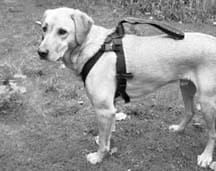Americans love their dogs and their cars, so it’s natural that you’ll frequently find them together. On any given day on any given highway across the United States you might see Fido in the Ford, Buddy in the Buick, and Chester in the Chevy. In fact, a whole branch of the pet supply industry has developed to help us make sure our canine pals are well cared-for as we cruise America. We checked out some car products so we could give you some hot tips on what’s cool in the car for Fido.
Safety first
Without a doubt, some sort of car restraint is the most important car accessory for a dog owner to buy and use. Many people think the use of canine seat belts (or some other restraint) is ridiculous; however, 20 years ago, many people thought seat belts for people were an unnecessary annoyance. Several thousand lives saved later, most people have gotten with the program and buckle up.
Besides, the use of restraints undeniably prevents canine injuries; who among us hasn’t, at some point in their driving career, had to slam on the brakes in traffic and had their dog flung against the seat, dashboard, or windshield in front of them? Restraints also save canine lives. Several years ago, my brother Bill lost his beautiful Australian Shepherd-mix in a horrible car accident. Lacy survived the impact, but, in a panic immediately after the crash, leaped through the shattered windshield and was killed moments later when she dashed under the wheels of a truck. Bill was fine – he was wearing his seat belt. What a tragedy that Lacy wasn’t.
While it’s true that one reason to crate or seat belt your dog in your car is to keep her as safe as possible in an accident, another is to keep you from being injured in a wreck. A free-flying dog body can become a deadly projectile, causing serious injury to you or other vehicle passengers if she hits them in mid-flight.
Finally, another good reason to restrain your dog in the car is to prevent her rambunctious antics from causing a wreck. (Did you all read the news accounts of famous author Stephen King being hit by a car, and seriously injured, by a driver who was reprimanding his dog while driving?)
Alternatives to crates
While a well-outfitted and well-secured crate would be our first choice for safe dog transport, we did not review crates for this article – that’s a product review all of its own! If you do use a crate to keep your dog safe in the car, it must be fastened down in some manner so it doesn’t become a projectile itself. And crates that shift and slide even in normal driving can be aversive to a dog and make him not like his car-crate.
But not everyone has room in their cars for crates, nor solid things to fasten them to. And the space required for multiple-dog households would certainly preclude each dog having his or her own transport crate, unless you drive a large van or school bus!
Fortunately, there are now a number of tethering devices on the market. Most interact in some way with your car’s seat belts, although there are some made to fasten to cargo hooks in trucks and SUVs.
For safety reasons, all restraint devices should be used with a harness, not a collar, so you’ll need to add the cost of a harness (about $3-15) to those products that don’t include one as part of the package. Also, dogs should always be buckled up in the back seat of your vehicle. Just like small children, they risk severe injury or death from air bags in the front seats of most newer cars. Remember: Air bags can be engaged in even very slow-speed accidents, but deploy with lighting speed and potentially dog-crushing force.
WDJ’s restraint selections
We’ll discuss the products we examined in descending order of our preference, beginning with the pet seat belts, and then discussing the car tethers.
We gave our top rating of four paws to only one product, the Doggie Catcher Pet Seat Belt, made by Smiling Dog Enterprises of Chattanooga, Tennessee (my own location, though I’d never examined this product before).
The Doggie Catcher is a simple and sturdy product that is fastened firmly in place with your car’s own seat belt. All the other canine restraints we examined were slipped over the fabric of the car’s seat belt, so they don’t prevent your dog from moving around. Also, all the other models rely on the locking action of the belt to restrain the dog in case of a sudden stop.
But the Doggie Catcher Pet Seat Belt is fastened right at the seat belt buckle – the stubby, fixed part – for maximum security. You actually slip the metal tongue of the seat belt through a slot in the Doggie Catcher’s molded plastic flange and then insert the tongue into the buckle as you normally would. A strong grey nylon strap is fastened to the Doggie Catcher’s flange; a snap at the other end clips onto the dog’s harness. Because it actually clips into belt latching mechanism, it secures the dog at a specific length of the restraint strap, adjustable from 12 to 18 inches. We especially like the extra plastic flap that covers the seat belt release mechanism and prevents the dog from stepping on it and accidentally getting loose.
We do have some very minor quibbles with the product. We support the efforts of animal control agencies, and have an aversion to the whole “Dog Catcher” image. We understand play on words, but we hate the phrase. We wish also the product was less expensive. At a suggested retail price of $20, this is a pretty high-priced item. Add another $3-15 or more for a harness, and you’re getting up there. Is your dog’s safety worth this much money? Of course it is. But not everyone will spend this much – and every dog ought to have one, in our opinion.
Three paws
Our enthusiasm for the next product has a lot to do with its exceptionally low price. The Kwik Klip Car Safety Harness is a harness and restraint device in one, so, at just $5-6.50 (depending on size), this is probably the best value of all the restraints we examined.
The harness is made of black nylon (not as heavy as the straps used by the Doggie Catcher), with a padded chest strap for comfort, and an extra loop protruding from the top of the harness, almost like a handle, but roomier. When the dog is harnessed and in his seat, the seat belt is passed through this loop and buckled closed.
Because the loop can slide on the belt, however, and because most seat belts lock only under sudden braking, the Kwik Clip does not hold the dog as securely in place as the Doggie Catcher does.
The plastic buckles on the harness appear sturdy, but are a little large and bulky for small dogs. Also, the harness straps slip through the buckles a bit too easily, so once you have fitted the harness appropriately for your dog you might want to sew the straps down to prevent them from loosening as your dog moves around.
Note: Many of the car restraint products contain valuable warnings about not leaving dogs in hot cars. The Kwik Klip does not, and it would be a nice addition to their packaging.
Two and a half paws
Here’s an incredibly low-tech (and low-cost) product: the Seat Belt Restraint made by Coastal Pet Products, Inc. This is a seven-inch black nylon strap with a snap at one end and a loop at the other. You simply snap it to the back of your dog’s harness, slip the car’s seat belt through the loop and buckle the seat belt closed. The strap can also double as a short leash in a pinch.
We’re a tad worried about the ability of the metal snap to restrain a larger dog, especially under the impact of a crash; it seems fairly lightweight. Also, as we’ve noted before, the loop-over-seat-belt design does not provide for optimum safety – the dog can still move around the car more than we would like.
Two paws
The Batzibelt Pet Seat Belt is similar in design to the product above, but gets a slightly lower rating from us, in part because it’s more than double the cost for essentially the same product.
The Batzibelt has a metal snap at each end, and uses a metal shackle (instead of a nylon loop) that slips over the seat belt fabric. We don’t see this as an improvement – the metal snaps are more likely to fail under pressure than nylon, so this product has two weak links instead of just one. The shackle is a separate piece – one of those small metal gadgets that we manage to lose all too easily.
Finally, the directions on the package suggest attaching the clip to the dog’s harness or collar – an instruction we find irresponsible, since a dog restrained by the collar in a sudden stop could injure or break his neck.
Tethers: fixed length
We’re using the word “tether” in this application to mean a product that restrains the dog and is fastened to something fixed in the car – not an adjustable seat belt.
Again, Smiling Dog Enterprises offers the product we liked best: the Doggie Catcher Pet Restraint. And again, we like this product’s sturdiness and simplicity. The same grey heavy-duty nylon strap is adjustable up to 24 inches in this permutation, with a strong metal D-ring sewn into each end. A “quick link” is linked to each D-ring, one that attaches to an anchor point in the back of a van or SUV; the other attaches to your dog’s harness.
However, we were dismayed to see promotional photos in the product’s brochure of the restraint being used on a dog’s collar (risking a broken neck in case of a sudden stop), and on a dog in the back of an open pickup truck. We would love to see safety products a little more consistent in the safety message they send!
The Travel Tether is another very usable product, losing a point in our estimation for being more complicated to put on the dog and install, and a little less sturdy than the Doggie Catcher. This product utilizes snaps (not as strong as metal links) to secure the dog to two anchor points of a van or SUV, effectively cross-tying him for maximum security. It is more expensive than the Doggie Catcher, but includes a harness.
We found the instructions for using the Travel Tether to be very poorly written. We finally put them aside and figured out how to get the harness on the dog ourselves. On the plus side, the fact that the tether clips onto a ring sewn into the bottom of the dog’s harness makes it harder for him to get tangled up. (The company also placed a ring on the top of the harness, to which a leash could be attached for walked the dog to or from the car – neat!) Finally, the tether appears to be well-made, and we love that it is not suggested for use in pickup trucks. We also appreciate the clear safety tips offered on the back of the package.
Also With This Article
Click here to view “Car Restraints For Dogs”
Click here to view “Car Safety For Canines”
Click here to view “WDJ’s Care Safety Harness Recommendations”







I can’t seem to find the Doggie Catcher restraint. Has the company gone under?